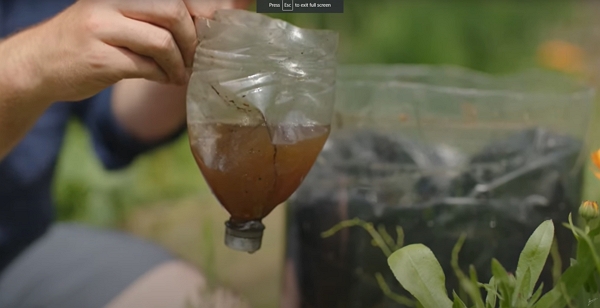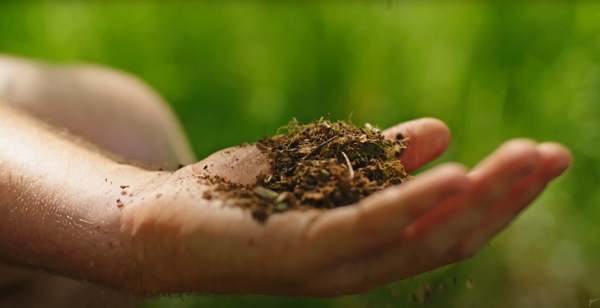Instead of buying expensive and dangerous plant feed, learn to make your own now.
Thanks to Huw Richards for sharing his wisdom and knowledge! I wrote the following notes watching the video published on Huw Richards’s channel. You can watch it using this YouTube link.
The technique is easy, very cheap.
When it’s even more important to use it
When rain isn’t falling, when compost prices increase beyond what we would expect, gardening can become challenging.
Huw believes we can grow food in a way that saves money.
And when finance challenges us, we learn to focus on the things that do matter.
What really matters in the garden is:
- the health of our plants at the end of the day,
- the health of the soil,
- the joy to be in the garden,
- and providing food for the household.
The recipe requires one expense: the container where you will put it in.
All the other ingredients are free!
Ingredients
Water
Any kind of soft water will do. The free source is the rain water.
The network water usually contains chlorine and we don’t want to have any microbes. To make this amendment, we rely on picking ingredients containing local microbes that will provide the proper nutrition to the plants.
Leaf mold
You need more than a handful.
For city people
You can use a well-decomposed compost instead.
This ingredient is the inoculant, it brings the biology that will help to make the amendment.
Plant matter
You can use any plant matter.
And you create a crop-specific feed that will change a lot of things in your garden.
What is JADAM
JADAM organic farming comes from Youngsang Cho who wrote a few books on the topic: check out his website.
One of the teaching is that the plant is its own fertilizer. By creating a liquid feed, you have the optimum elements to grow strong crops.
Personal note
It’s game-changing in a world where many think we need industrial fertilizers.
When you can make a liquid feed with so little effort and at a price that beats anything, why would one go for industrial fertilizers?
As an example: a fruit tree will produce leaves and fruits that will fall to the ground, decompose and feed the tree for the next year. JADAM uses the same principle.
Optimum liquid amendment
To make any liquid amendment, you need the plant fresh to make the liquid.
You need to use the entire crop, not just the leaves or the roots.
Personal note
That means that you won’t be able to make this amendment until the crops are growing already.
That might be tricky if your don’t have a lot of the particular plant.
How to create a high-quality feed
Since you need to use the whole plant, you will use what you eat.
The good news is you don’t need that many.
Don’t worry about sacrificing some of the crops!
One caveat
JADAM is designed for big agriculture operation.
When you have a little garden, how are you going to make all the specific liquid feeds for your crops?
Huw suggests to create a group or family of amendments. For example, make a Braceassus amendment for the family of cabbages, broccolis and so on.
Disclaimer: he hasn’t tried and will tell us how this work out.
Personal note
This caveat came to my mind.
I’m blessed to have a local free source of 5 liter containers. I get them from buying sauerkraut in them.
We eat a lot and we can get about 1 container per month from November to March.
The recipe
- Decide what plant matter you will use.
- Cut and smash the big piece to help with the breakdown.
- Fill the container full.
- Add soft water to cover the plant matter.
- Sprinkle a handful of leaf mold or good compost.
You don’t need to mix the leaf mold.
Finally, put on the container lid loosely.
Done!
Wait two weeks before you can use in a dilution
Dilution ratio
You can use a 1:30 ratio with soft water.
As the JADAM solution ages, you will need to increase the ratio.
Dilution ratios (approximate): 2 weeks: 1:30 1 month: 1:50 3 months: 1:100 6 months: 1:200 1 year: 1:400/1:500
How to use it
Use it as a supplement.
It isn’t about getting massive crops but more about healthy and nutritious-densed crops.
More traditional feeds
You can continue using:
- comfrey feed to help tomatoes
- or grass feed for seedlings (see GRASS - The Most Valuable FREE Resource for Growing Food).
How to maintain your JADAM liquid feed
As you extract liquid from the container, never take any of the solid.
As the liquid levels go down, top it up with more water and more of the exact same crop.
It will be smelly :)
Not everything has to be aerobic.
It’s easy to fallback to JADAM liquid feed
As we saw, since it’s easy to make, and rather fast to become ready, we can rely on this method.
Transplanting with JADAM liquid feed
When you transplant a plant, adding some JADAM liquid feed to the water used will help the plant get the minerals and nutrients it needs.
Also, get into the habit to use JADAM liquid feed once or twice a month when you’re watering. See the ratio above.
Takeaway
Start making your JADAM liquid feed now, no matter where you’re at when you read this.
I will make more comments about the technique in a year time.



